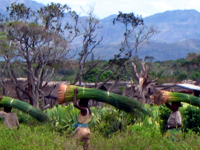Biodiversity & Conservation
We study how disturbances alter the biodiversity and functioning of natural ecosystems. Our aim is to provide policy and management solutions for complex social, economic and environmental challenges, such as sustainable development, land-use change and the provision of ecosystem services.
Amongst our research goals are:
 (i) understanding the impacts of forest fragmentation on biotic processes, including seed dispersal and predation of herbivorous insects
(i) understanding the impacts of forest fragmentation on biotic processes, including seed dispersal and predation of herbivorous insects
(ii) using landscape-scale experiments and global plot-based surveys to test the link between biodiversity and ecosystem function, including the functioning of biogeochemical cycles
(iii) using comparative analyses to test how species ecology and evolutionary history influences the responses of ecosystems to land-use and climate change
(iv) investigating the role of animals in regulating the recovery of biodiversity and ecosystem function in regenerating rainforests
HumBug: we are using smartphones to record and identify mosquitoes by their flight tones
Mosquitoes are notoriously dangerous, responsible for over one billion cases of disease and around a million deaths each year. Malaria alone kills ... Continue reading
Mammal defauntation and trophic cascades in Ethiopia
Large mammals have been widely recognized to play key roles in ecosystem functioning. In many ecosystems, small mammals also drive ecosystem ... Continue reading
Evidence Based Forestry & Landuse
Other sectors have well-established procedures for using systematic, evidence-informed approaches to science-policy dialogue. These include Health Care (Cochrane Collaboration), ... Continue reading
Palaeo-Trophic Cascades (PACE)
The extinction of a number of large herbivores (e.g. Mammuthus primigenius, woolly mammoth and Megaloceros giganteus, giant deer) at the end of the Pleistocene epoch ... Continue reading
Paleo-Progressive Nitrogen Limitation (PNL)
Is nitrogen (N) availability to plants increasing or decreasing over time? Global environmental changes such as N deposition, climate warming and increasing atmospheric CO2 concentrations are ... Continue reading
Local Ecological Footprinting Tool (LEFT)
LEFT is an internet-based decision support tool for evaluating the pattern of relative ecological value across a landscape. Such knowledge can help minimise environmental impact when ... Continue reading
Restoring native biological diversity in the Galápagos Islands: determination of baseline ecological conditions
The Galápagos Islands are a National Park, UNESCO World Heritage site and Biosphere Reserve and are globally renowned both for their ecological value ... Continue reading
Forest Conservation in a Changing World: using palaeoecology to improve the effectiveness of conservation planning in the Apuseni Mountain, NW Romania
One region in Europe where there are still exceptionally large tracts of 'undisturbed' natural temperate forests is in Romania. In order to plan ... Continue reading
Potential impacts of climate change on biodiversity and ecosystem function in small-holder agro-ecosystems in Northern Ghana
Small-holder farmers play an influential role in prevailing environmental conditions across the globe - constituting 80% people in sub-Saharan Africa alone, and 2 billion globally. ... Continue reading
Rapid Ecosystem Service Assessment Technique (RESAT) : An indicator methodology for assessing ecosystem processes and function, goods and services, and human well-being in agricultural landscapes
Despite the widening debate on ecosystem service (ES) provision and growing spectrum of ecosystem assessment tools, land managers and researchers in the ES community still ... Continue reading
How effective are on-farm conservation land management strategies for preserving ecosystem services in developing countries?
While ecosystem service valuation is commonly justified as a tool that can enhance decision making at landscape level through monitoring, planning or prioritization, there is ... Continue reading
EcoSET
Biodiversity provides vital goods and services, such as pollination, food provision, carbon sequestration and water regulation that strengthen economic prosperity. While conservation planning for biodiversity ... Continue reading
NaturEtrade
This demonstration project has been successfully completed. The overall aim of NaturEtrade was to develop an innovative solution to the loss of ecologically-rich land in ... Continue reading
Linking soil management to ecosystem functions and services in oil palm plantings
The rapid expansion of oil palm cultivation in Southeast Asia in the past decades has led to deforestation, loss of biological diversity, poor water quality ... Continue reading
Resilience of Tropical Peat Swamp Forests
Tropical peat swamp forests are undergoing some of the most rapid rates of deforestation and land use change on earth. As well as being rich ... Continue reading
Holocene tree-cover in Europe and implications for re-wilding strategies
This thesis addresses the methodological challenges of determining the variability of large herbivore populations through time and their impact on ... Continue reading
Impact of EU Agri-environment policies on ecosystem functioning
Catherine's DPhil focuses on assessing the effectiveness of EU agri-environment schemes in promoting ecosystem functioning and service delivery within agricultural landscapes. Agri-environment schemes have been ... Continue reading
Retrospectively evaluating the effectiveness of Community Based Conservation projects in Madagascar
Herizo Andrianandrasana DPhil project involved an evaluation of the effectiveness of Community based Conservation (CBC) in mitigating threats, saving biodiversity, protecting ecosystem services and enhancing ... Continue reading
80,000 years of climate change and forest resilience in the Eastern Mediterranean
This research aimed to systematically investigate the influence of climate variability on vegetation dynamics and landscape processses in the Bekaa Valley and on the Lebanon ... Continue reading
Optimising Protected Area Networks in Europe
Europe not only contains multiple biogeographic regions and considerable habitat space for biodiversity, but also boasts a plethora of conservation designations on various levels of ... Continue reading
Unravelling biofuel impacts on ecosystem services, human wellbeing and poverty alleviation in Sub-Saharan Africa
Members from other institutions Stockholm Environment Institute Dr. Francis Johnson (http://www.sei-international.org/staff?staffid=26) & Dr. Caroline Ochieng (http://www.sei-international.org/staff?staffid=325) Council for Scientific and Industrial Research of South Africa: Dr. ... Continue reading
Agro-economic and ecological impact of GM and non-GM cotton farming in India
The commercialisation of genetically modified (GM) crops has raised a polarised debate concerning environmental risks and the potential socio-economic impacts on farmers. A proper assessment ... Continue reading
Long Term Biodiversity Change of Canary Islands
The ancient forests of Macaronesia (Canary Islands and Cape Verde) and their sensitivity to environmental change... Continue reading
BioSound
Biodiversity monitoring is a key element of environmental and ecosystem protection planning and policy design. For a large number of animal species that produce ... Continue reading
